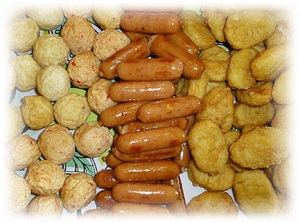
What's a Healthy Body Fat Composition?
Our body fat percentage is simply the percentage of fat your body contains. If you are 150 pounds heavy and 10% fat, it means that your body consists of 15 pounds fat and 135 pounds lean body mass (bone, muscle, organ tissue, blood and everything else).
Your ideal weight and fat-lean ratio varies considerably for men and women and by age, but the minimum percent of fat in the body considered safe for good health is 5% for males and 12% for females. The average adult body fat is closer to 15-18% for men and 22-25% for women. Athletes tend to be at low end of this scale due to their increased lean weight (muscle mass).
Most people don't need to worry about not getting enough fats in their diets because it's virtually impossible to have a fat-free diet. Most foods, even fruits and vegetables, provide small amounts of fat. However, consuming too much fat is often an issue. Most nutrition experts believe that dietary fat is a major cause of obesity, heart diseases, diabetes, cancer, Alzheimer's disease, and physical and mental stress. Hence, we should all avoid a high-fat diet. But how much fat can we eat? How much fat considered too much?
How Much Fat Can I Eat?

To make a rough estimation of your fat intake for weight maintenance, here is a very simple method. First you need to know your daily caloric intake which will depend on how physically active you are:
• Sedentary or inactive: Your weight multiplied by 12.
• Moderately active. Weight multiplied by 14.
• Very active: Weight multiplied by 16 to 18
Let's say you weigh 150 pounds, and you lead a sedentary lifestyle. To maintain your weight, your calorie intake should be 150 X 12 = 1800 calories. You can have 20% to 30% of your calories as fat, or about 540 calories a day. Each gram of fat contains 9 calories, so you can take 540 divided by 9 = 60 grams of fat. If you are overweight, use your ideal weight, otherwise you would be taking too much fat. (Note: 4g of fat equals 1 teaspoon of fat) This is only a rough gauge of the energy intake. Your daily calorie intake depends on a number of other factors, including your body size, gender, age, and nutrition goals. For instance, younger people can eat more fat than older people, and men are allowed more fat than women.
Many people find it hard to measure and keep track of the amount of fats in every food we eat every day. This doesn't mean we can then party on fats. You can write down everything you eat or drink before you start; write down the name of foods, how they are prepared and approximately how much you ate including the quantity. Keep track of fat grams on food labels, but the problem is that some basic foods like fruits, vegetables and meats as well as restaurant foods don't have food labels. The key to lose weight and body fat is undereat fats that body needs as well as eat the right types of fat. Consciously choose the kind of food to eat, and decide on the choice of fat, whether they are good fats or bad fats.
Jolting Facts About Dieting
Astonishing health and nutrition findings from The Honey Revolution by Dr Ron Fessenden crush well-known myths and theories about dieting: Health and Nutrition: 5 Jolting Findings.
End of "What's a Healthy Body Fat Composition?". Back to "Health Food Matters".